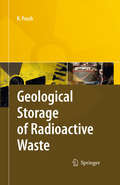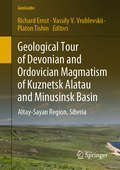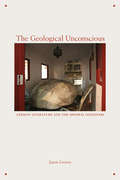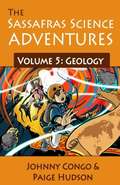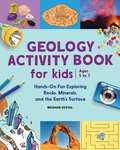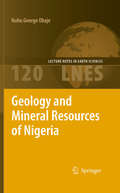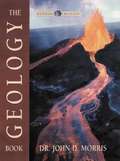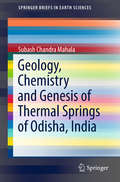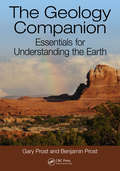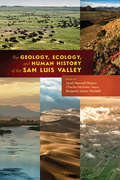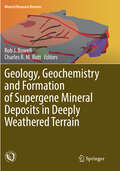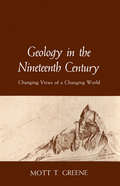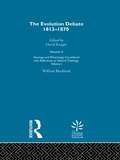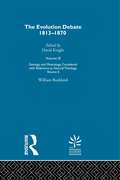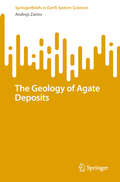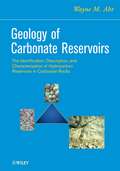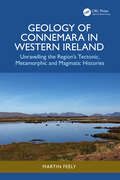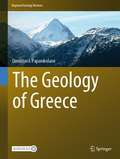- Table View
- List View
Geological Storage of Highly Radioactive Waste
by Roland PuschThe book describes and assesses current concepts for long-term disposal of highly radioactive waste. Different types of rock are discussed and assessed with respect to practical difficulties in the construction of a repository, and the efficiency of isolating radioactive waste. Safety matters are most important and are treated in the respective chapters and in a final, conclusive chapter. Cost issues and related quality matters are discussed for the case of constructing a virgin repository and repositories in the form of converted abandoned mines.
Geological Tour of Devonian and Ordovician Magmatism of Kuznetsk Alatau and Minusinsk Basin: Altay-Sayan Region, Siberia (GeoGuide)
by Richard Ernst Vassily V. Vrublevskii Platon TishinThis volume provides an overview and tour (with many interesting stops along the way) of Devonian and Ordovician intraplate magmatism and associated sedimentary rocks and tectonics in the regions of Kuznetsk Alatau, Minusinsk Basin and Khakassia in western Siberia. All chapters were written by experts, many of which have been studying these regions for decades. The first book to present and review this information in English for an international audience, it includes both overviews of the magmatic and associated sedimentary history, and selected key field sites, which are described in detail.
The Geological Unconscious: German Literature and the Mineral Imaginary
by Jason GrovesAlready in the nineteenth century, German-language writers were contending with the challenge of imagining and accounting for a planet whose volatility bore little resemblance to the images of the Earth then in circulation. The Geological Unconscious traces the withdrawal of the lithosphere as a reliable setting, unobtrusive backdrop, and stable point of reference for literature written well before the current climate breakdown.Through a series of careful readings of romantic, realist, and modernist works by Tieck, Goethe, Stifter, Benjamin, and Brecht, Groves elaborates a geological unconscious—unthought and sometimes actively repressed geological knowledge—in European literature and environmental thought. This inhuman horizon of reading and interpretation offers a new literary history of the Anthropocene in a period before it was named.These close readings show the entanglement of the human and the lithic in periods well before the geological turn of contemporary cultural studies. In those depictions of human-mineral encounters, the minerality of the human and the minerality of the imagination become apparent. In registering libidinal investments in the lithosphere that extend beyond Carboniferous deposits and beyond any carbon imaginary, The Geological Unconscious points toward alternative relations with, and less destructive mobilizations of, the geologic.
Geology (Sassafras Science Adventures #5)
by Johnny Congo Paige HudsonTake an adventure to learn about rocks and more with Sassafras Science! In The Sassafras Science Adventures Volume Five: Geology, the zip-lining science adventure rolls on for Blaine and Tracey Sassafras! The twins and your students will learn about rocks, fossils, maps, and more as they zip around the globe visiting the Norwegian countryside, the ice of Antarctica, and a deep, dark cavern in Australia! Don’t miss a minute of their summer-long zip line journey with their crazy Uncle Cecil!
Geology 103: Physical Geology Laboratory Manual
by Robert Leighty Donna BensonIn this Introduction to Physical Geology lab, you will acquire skills that you can use to make discoveries about your natural surroundings. Every week you will learn and apply basic concepts in exercises related to real places in Arizona and around the world. Many of the activities in this class are designed to compliment each other to help reinforce your learning. The goal will be accomplished if you come away from this class with more confidence in your knowledge of geology and with a greater appreciation of the natural world around you.
Geology Activity Book For Kids: Hands-On Fun Exploring Rocks, Minerals, and the Earth's Surface
by Meghan VestalHelp kids discover how mountains are formed and rocks are made with this interactive geology book for ages 5-7Learning about rocks and minerals is a lot more fun when kids can get their hands dirty. This book on rocks teaches budding scientists all about planet Earth through 19 geological topics that feature hands-on experiments, on-page activities, and fascinating facts.What sets this geology book apart from other rock books for kids:Real-life experiments—Kids can see what it's like to be a geologist with simple yet fascinating experiments such as pulling core samples from a candy bar, growing crystals, and creating a volcanic eruption!Earth-based activities—A variety of games, puzzles, and facts help young readers better understand geological concepts and build their scientific vocabulary.Rock spotting—This is also a rock identification book where kids can learn how to identify the rocks and minerals being used in the world around them, from the kitchen to the classroom.Inspire geology kids with this interactive exploring nature activity book—it's a standout among geology books for kids.
Geology and Mineral Resources of Nigeria
by Nuhu George ObajeContains details on the geological units of Nigeria and the associated mineral resources. The book is divided into three parts. Part 1 discusses the geology of the crystalline rocks and their regional distribution while the sedimentary basins constitute the subject of Part 2. Part 3 takes the mineral resources of Nigeria one on one, their geological environment, mode of occurrence, localities and where possible the reserves estimation. Thereafter, an account of the previous and current mining policies (including that of petroleum) of the Nigerian government is given and goes ahead to list some specific investment opportunities in the solid minerals sector.
The Geology and Tectonic Settings of China's Mineral Deposits
by Franco PirajnoExtensive descriptions of a wide range of key or world-class mineral deposits of China are presented in the context of the country's general geology, tectonic units and mineral systems and their geodynamic evolution within the tectonic framework of the Asian continent. This comprehensive overview, incorporating the latest geological concepts, is the first such coverage written in English by a western expert, and will be of benefit to mineral explorers and miners, as well as to research scientists and students in institutions of higher education. In his compilation of this compendium of Chinese geology and mineral systems, Franco Pirajno draws on first-hand knowledge of China's geology and mineral deposits gained in numerous field visits and research projects with Chinese colleagues from various academic institutions over the past 18 years. First time that a western-based book on China's geology and mineral deposits is published Appropriate for use by the mineral exploration industry Modern English-language geological and mineral deposits information on China Most useful to Western (and Chinese) geoscientists
The Geology Book
by John D. MorrisThe Geology Book explores the physical features of the planet from core to crust, explaining earthquakes, volcanoes, geysers, rock layers, and the age of the earth.
Geology: Reader (Amplify Core Knowledge Language Arts, Grade 4 #Unit 5)
by Amplify EducationNIMAC-sourced textbook
Geology, Chemistry and Genesis of Thermal Springs of Odisha, India (Springerbriefs In Earth Sciences Ser.)
by Subash Chandra MahalaThis book presents a comprehensive overview of the nature of manifestation and general aspects of thermal springs of Odisha. A detailed description of geological formations and the relationship between tectonic settings with thermal spring emanation is given for better understanding of the geothermal system. Physico-chemical characteristics of water and gas have been studied and interpreted to ascertain the nature and source of geothermal fluid and to generate a conceptual model on the origin. The book can serve as a valuable reference for earth scientists, planners and researchers in the field of geothermal energy. As the thermal springs are spectacular sites for tourists this illustrated book can also help tourists, tourist guides and tourism departments.
The Geology Companion: Essentials for Understanding the Earth
by Gary Prost Benjamin ProstThis practical guidebook provides a basic grounding in the principles of geology and explains how to apply them. Using this book, readers will be able to figure out whether they are standing on an ancient seafloor, coal swamp, or sand dune. They will be able to determine the geologic hazards in their neighborhood, where to look for fossils and minerals, or where best to drill a water well. In plain English, The Geology Companion sheds light on the processes that shape the earth and how geology affects people in their daily lives.
The Geology, Ecology, and Human History of the San Luis Valley
by Jared Maxwell Beeton Charles Nicholas Saenz Benjamin James WaddellThe Geology, Ecology, and Human History of the San Luis Valley explores the rich landscapes and diverse social histories of the San Luis Valley, an impressive mountain valley spanning over 9,000 square miles that crosses the border of south-central Colorado and north-central New Mexico and includes many cultural traditions. Twenty-six expert scholars and educators—including geologists, geographers, biologists, ecologists, linguists, historians, sociologists, and consultants—uncover the natural and cultural history of the region, which serves as home to the Sangre de Cristo Mountains, the San Juan Mountains, Great Sand Dunes National Park and Preserve, and the Rio Grande headwaters. The first section, “The Geology and Ecology of the San Luis Valley,” surveys the geomorphology, hydrology, animal and plant life, conservation, management, and mining of the valley’s varied terrain. The second section, “Human History of the San Luis Valley,” recounts the valley’s human visitation and settlement, from early indigenous life to Spanish exploration to Hispanic and Japanese settlements. This section introduces readers to the region’s wide range of religious identities—Catholic, Latter-day Saint, Buddhist, Jehovah’s Witness, Amish, and Mennonite—and diverse linguistic traditions, including Spanish, English, Dutch, Danish, Japanese, and Mayan. The final section, “Travel Itineraries,” addresses recreation, specifically fly-fishing and rock climbing. The book provides a comprehensive overview of the endemic flora and fauna, human history of indigenous lifeways, and diverse settlement patterns that have shaped the region. The Geology, Ecology, and Human History of the San Luis Valley will appeal to students and scholars of geology, ecology, environmental history, and cultural history, as well as residents and tourists seeking to know more about this fascinating and integral part of Colorado and New Mexico. Contributors: Benjamin Armstrong, Timothy Armstrong, Deacon Aspinwall, Robert Benson, Lorrie Crawford, Kristy Duran, Jeff Elison, Eric Harmon, Devin Jenkins, Bradley G. Johnson, Robert M. Kirkham, Bessie Konishi, Angie Krall, Richard D. Loosbrock, Richard Madole, A. W. Magee, Victoria Martinez, James McCalpin, Mark Mitchell, R. Nathan Pipitone, Andrew Valdez, Rio de la Vista, Damián Vergara Wilson
Geology, Geochemistry and Formation of Supergene Mineral Deposits in Deeply Weathered Terrain (Mineral Resource Reviews)
by Rob J. Bowell Charles R. M. ButtThis book provides a comprehensive overview of the major supergene mineral deposits formed in intensely weathered lateritic terrains. It discusses both contemporary and pre-existing supergene deposits, describing their geological, mineralogical and geochemical characteristics. Supergene processes of enrichment are those that occur under ambient near-surface conditions, compared to hypogene processes mostly at depth under higher temperatures and pressures. Supergene processes include the predominance of meteoric water circulation with concomitant oxidation and chemical weathering. Descending meteoric waters oxidize the primary (hypogene) minerals and redistribute the chemical elements. Residual supergene enrichment occurs as a physical process when the predominant rock-forming minerals oxidize and dissolve, concentrating ore elements hosted in resistant stable minerals; absolute chemical enrichment occurs when the ore elements themselves are leached and migrate in groundwater and precipitate due changes in the pH, oxidation potential and chemical composition of water. These processes can enrich commercially important elements to produce orebodies formed entirely by supergene processes. These include Al (bauxite), Fe ore, Ni-Co laterites, kaolinite, REE (clay deposits), Nb and REE (on carbonatites), base metals (secondary <span class="
Geology, Geography, and Climate (North Dakota Studies)
by Gwyn S. Herman Laverne A. JohnsonThis book is filled with interesting and useful information about the geology, geography, and climate of North Dakota. Through reading and engaging in the variety of activities that accompany this text, you will find this journey of discovery to be enjoyable and exciting! What was North Dakota like before there was a North Dakota? What happened to make North Dakota what it is today? Why is North Dakota such a special place?
Geology in the Nineteenth Century: Changing Views of a Changing World
by Mott T. GreeneIn this clear and comprehensive introduction to developments in geological theory during the nineteenth century, Mott T. Greene asserts that the standard accounts of nineteenth-century geology, which dwell on the work of Anglo-American scientists, have obscured the important contributions of Continental geologists; he balances this traditional emphasis with a close study of the innovations of the French, German, Austro-Hungarian, and Swiss geologists whose comprehensive theory of earth history actually dominated geological thought of the time. Greene's account of the Continental scientists places the history of geology in a new light: it demonstrates that scientific interest in the late nineteenth century shifted from uniform and steady processes to periodic and cyclic events—rather than the other way around, as the Anglo-American view has represented it. He also puts continental drift theory in its context, showing that it was not a revolutionary idea but one that emerged naturally from the Continental geologists' foremost subject of study-the origin of mountains, oceans, and continents. A careful inquiry into the nature of geology as a field poised between natural history and physical science, Geology in the Nineteenth Century will interest students and scholars of geology, geophysics, and geography as well as intellectual historians and historians of science.
Geology & Mineralogy, Considered with Reference to Natural Theology, Volume I, 1836 (The\evolution Debate, 1813-1870 Ser.)
by William BucklandMoving away from his earlier belief in a short, catastrophic history of the Earth, this volume shows how Buckland envisages instead progressive change as the Earth gradually cooled as it was prepared for human occupation. Extinct creatures did not die out because they were poorly designed; God loved the dinosaurs and had adapted them to their various circumstances.
Geology & Mineralogy, Considered with Reference to Natural Theology, Volume II, 1836
by William BucklandMoving away from his earlier belief in a short, catastrophic history of the Earth, this volume shows how Buckland envisages instead progressive change as the Earth gradually cooled as it was prepared for human occupation. Extinct creatures did not die out because they were poorly designed; God loved the dinosaurs and had adapted them to their various circumstances.
The Geology of Agate Deposits (SpringerBriefs in Earth System Sciences)
by Andrejs ZarinsThis book examines agate provinces through the lens of plate tectonics, stratigraphy, agatization, and more. It delves into the physical and chemical properties of agate deposits, their environments of formation, and related silica deposits like opal, chert, and petrified wood. Examples, illustrations, maps, and thin-section photos illuminate structural, chemical, and temporal controls. Plate tectonics and lithotectonics are explored to provide a deeper understanding of the volcanic processes behind agate formation.
The Geology of Australia
by Robert Henderson David JohnsonThe Geology of Australia provides a vivid and informative account of the evolution of the Australian continent over the last 4400 million years. Starting with the Precambrian rocks that hold clues to the origins of life and the development of an oxygenated atmosphere, it goes on to cover the warm seas, volcanism and episodes of mountain building, which formed the eastern third of the Australian continent. This illuminating history details the breakup of the supercontinents Rodinia and Gondwana, the times of previous glaciations, the development of climates and landscapes in modern Australia, and the creation of the continental shelves and coastlines. Separate chapters cover the origin of the Great Barrier Reef, the basalts in Eastern Australia, and the geology of the Solar System. This second edition features two new chapters, covering the evolution of life on Earth while emphasising the fossil record in Australia, and providing a geological perspective on climate change. From Uluru to the Great Dividing Range, from earthquakes to dinosaurs, from sapphires to the stars The Geology of Australia is a comprehensive exploration of the timeless forces that have shaped this continent.
The Geology of Australia
by David JohnsonThe Geology of Australia provides a vivid and informative account of the evolution of the Australian continent over the last 4400 million years. Starting with the Precambrian rocks that hold clues to the origins of life and the development of an oxygenated atmosphere, it goes on to cover the warm seas, volcanism and episodes of mountain building, which formed the eastern third of the Australian continent. This illuminating history details the breakup of the supercontinents Rodinia and Gondwana, the times of previous glaciations, the development of climates and landscapes in modern Australia, and the creation of the continental shelves and coastlines. Separate chapters cover the origin of the Great Barrier Reef, the basalts in Eastern Australia, and the geology of the Solar System. This second edition features two new chapters, covering the evolution of life on Earth while emphasising the fossil record in Australia, and providing a geological perspective on climate change. From Uluru to the Great Dividing Range, from earthquakes to dinosaurs, from sapphires to the stars The Geology of Australia is a comprehensive exploration of the timeless forces that have shaped this continent.
Geology of Carbonate Reservoirs
by Wayne M. AhrAn accessible resource, covering the fundamentals of carbonate reservoir engineeringIncludes discussions on how, where and why carbonate are formed, plus reviews of basic sedimentological and stratigraphic principles to explain carbonate platform characteristics and stratigraphic relationshipsOffers a new, genetic classification of carbonate porosity that is especially useful in predicting spatial distribution of pore networks.Includes a solution manual
Geology of Connemara in Western Ireland: Unravelling the Region’s Tectonic, Metamorphic, and Magmatic Histories
by Martin FeelyThe Connemara region in Western Ireland is world-renowned for its outstanding geology that is blended with spectacular landscapes. This book and its many colourful illustrations, maps, diagrams, field and landscape images detail the origin and formation of Connemara’s metamorphic and igneous rocks in deep time from 700 to 380 million years ago. It combines many field geology observations and current research results, and describes the many geological processes involved in the formation of the bedrock foundations of Connemara: plate tectonics, granite magmatism, deformation, metamorphism and mineral deposits. An amazing book for students and geological societies that visit the region annually.Features The only book available on the formation of the igneous and metamorphic rock complexes in Connemara Explores the regional geological context of Connemara from ~700 Ma to 385 Ma Incorporates the most up-to-date research results and many useful field images, maps and schematic diagrams for teacher and student alike Describes the deformation, metamorphic and magmatic histories in Pressure-Temperature-time (PTt) space Includes a chapter dedicated to the application of fluid inclusion studies to magmatic and hydrothermal mineralization in the Galway Granite Complex and its environs This book serves as a resource for professionals, academics and senior undergraduate and graduate students working and studying in the fields of geology, earth sciences and environmental sciences.
The Geology of Greece (Regional Geology Reviews)
by Dimitrios I. PapanikolaouThis book introduces the reader to the unique geology of Greece. This country is a natural geology laboratory that can help us understand the present-day active geodynamic processes in the Hellenic orogenic arc, including earthquakes, volcanoes, coastline changes and other processes of uplift and subsidence, as well as the intense erosion, transport and deposition of sediments. Additionally, Greece offers a remarkable geological museum, reflecting the complex history of the area over the last 300 million years. By studying the rocks of Greece, one can discover old oceanic basins, e.g. in the Northern Pindos and Othrys mountains, crystalline rocks of Palaeozoic age, old granitic and volcanic rocks, as well as other sedimentary rocks including fossils from the shallow neritic facies to pelagic and abyssal facies. The younger sediments demonstrate the continuously changing palaeogeography of Greece, with areas of lakes, high plateaus and gulfs that are transformed into new forms of islands, peninsulas or high mountains, etc. All the above subjects are included in the book, which describes the tectonic structure of the geological strata, together with the evolutionary stages of the palaeogeography and geodynamics within the broader Mediterranean context. A special characteristic of the book is the development of the orogenic model of the Hellenides with the application of the tectono-stratigraphic terrane concept in the Tethyan system.
